Truffles: everything you need to know
Introduction
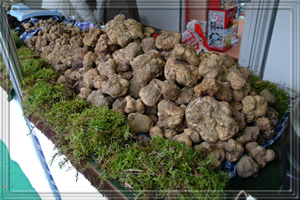
A truffle is a fungal fruiting body that develops underground. It relies on mycophagy for spore dispersal. Almost all truffles are usually found in close proximity with trees. There are hundreds of species of truffles, but the genus Tuber specie is the most highly prized as foodstuff. Edible truffles are held in high esteem in French and northern Italian cooking, as well as in the international haute cuisine.
The mycelia of truffles form symbiotic relationships with the roots of several tree species, including beech, poplar, oak, birch, hornbeam, hazel, and pine. They prefer argillaceous or calcareous soils which are well drained and neutral or alkaline. Truffles fruit throughout the year, depending on the species, and can be found buried between leaf litter and soil.
The origin of the word truffle appears to be the Latin word tuber, meaning "lump", which later became tufer and gave rise to the various European terms: French truffe, Spanish trufa, German Trüffel, Dutch truffel and in piedmontese "Le Trifole". In Portuguese, the words trufa and túbera are synonyms — the latter closer to the Latin term. The German word Kartoffel ("potato") is derived from the Italian tartufo (truffle) due to superficial similarities.
Truffle History
Antiquity:
Even if the first mentions of truffles appears in the inscriptions of the Neo-Sumerian regarding their Amorite enemy's eating habits and later in writings of Theophrastus in the fourth century BC. From scientific studies we know that truffles were on the earth much earlier than humans, probably between 360 and 280 million years ago.
During the Paleozoic period, thanks to the beetles, spores started to spread all over the world. Some fossils (Tuber Spinoreticolatum) have been found in Northern America and one very special has also been found in Italy (Piedmont region): it was dormant since 300 million years!
In classical times truffle origins was a mystery which challenged many. In 3000 BC Babylonians already used to search for truffles on beaches and in the sands of desert. Truffles were loved by Aphrodite, Love Goddess (Philoxenus of Lefkas was among the first who spoke about its aphrodisiac powers). Plutarch thought truffles were the result of lightning, warmth and water in the soil, while Juvenal thought thunder and rain to be instrumental in their origin. Cicero deemed them as children of the earth, while Dioscorides thought they were tuberous' roots. A legend says that truffles are born in the point where thunderbolts thrown by Zeus meet the earth.
During the Classical Period in Italy two kinds of truffles were produced: the Tuber Melanosporum and the Tuber Magnatum.
During the Middle Age peasant used truffles to give taste to different dishes. It was appreciated by Savoia family and it was a well-established custom of Acaja princes to give it as present to the Bourbons. Traces of truffles in medieval cooking can also be found at the court of the Avignon Papacy. The popes discovered them after they relocated to Avignon, near the producing regions of upper Provence, and they became very fond of them. Truffle hunting is also mentioned by Bartolomeo Platina, the papal historian, in 1481, when he recorded that some sows were without equal in hunting truffles, however they should be muzzled to prevent them from eating the prize.
Renaissance:During the Renaissance truffles regained popularity in Europe and were honoured at the court of King Francis I of France. However, it was only during the 17th century that Western (and in particular French) cuisine abandoned "heavy" oriental spices, and rediscovered the natural flavour of foodstuffs. Truffles were very popular in Parisian markets in the 1780s. They were imported seasonally from truffle grounds, where peasants had long enjoyed their secret. Brillat-Savarin (1825) noted characteristically that they were so expensive they appeared only at the dinner tables of great nobles and kept women. A great delicacy was a truffled turkey. "I have wept three times in my life," Rossini admitted. "Once when my first opera failed. Once again, the first time I heard Paganini play the violin. And once when a truffled turkey fell overboard at a boating picnic."
1700 - Today:In this period truffles' history starts to be more scientifically coherent, but obviously this didn't change their taste. In Versailles royal palace they are always present and many people tried to study them but only in 1699, an English researcher, John Ray found some micro-structures in truffles, later known as spore.
In 1711 the French botanist Etienne François Geoffroy has been among the first to identify truffle as a kind of mushroom and in 1729 the Florentine Giovanni Bernardo Vigo will correctly identify two kinds of black truffle: Tuber Melanosporum and Tuber Aestivum.
In 1780, the Polish Michel-Jean de Borch, in “Lettres sur les truffles du Piemont” described very precisely the morphological and organoleptic characteristics. The sublime quality of Italian truffle was mentioned also by Urbain Dubois that in his two books “La Cuisine de touts les pays” and “Cuisine Classique” wrote many suggestions about how to use truffles: “Truffes Blanches du Piemont” and “Fondue aux truffes de Piémont”.
At the end of 19th century at Turin's University, professor Giuseppe Gibelli, thanks to the discovery of mycorrhizae, started to think about truffles cultivation. During the following years a farmer had a very good idea: sow acorns produced by symbiont oaks for Melanosporun Truffle, and in this way he obtained good black truffles.
During the 20th century, white truffles had become more and more widely known and Piemonte has become very famous for its Alba Truffles. After WW2, during the 70s, white truffles' collection had become widespread in Monferrato, Roero, Monregalese, Valli Curone, Grue and Ossona regions and now this Tuber has a very good placement in both national and international fiers.
Truffles’ kinds
The classification of different species of truffles is based primarily on morphological characteristic such as shape, size, colour, ornamentation of the peridium, trama aspect, smell and taste.
The different species are identified in the laboratory through the recognition of spores or through molecular-biological analysis techniques.
In the world of fungi species there are about 63 that are currently classified as tubers; in Italy there are 25, but only 9 are edible and 5 are the most commonly marketed: Tuber Magnatum Pico, Tuber Melanosporum Vitt.,Tuber Aestivum Vitt., Tuber Borchii Vitt. and Tuber Brumale Vitt.
White truffle (Tuber Magnatum Pico)
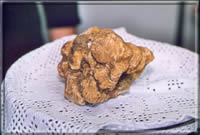
The white truffle (Tuber Magnatum Pico) is the most widely known truffle because of its taste and commercial importance.
It has a globular shape, with numerous depressions on the peridium that make it irregular. The outer surface is smooth and slightly velvety. The colour varies from pale cream to dark cream to greenish. Its flesh is unmistakable and it is white or greyish yellow with thin white veins.
It smells pleasantly aromatic and contrary to other types of truffles it does not have a garlic-like smell. This makes it unique. It lives in symbiosis with oak trees (in this case it takes a dark hazelnut colour), lime trees, poplars and willows (in this case it is almost white) and is rarely found in combination with other truffles. It also has red marks if it lives in symbiosis with the linden. The white truffle, to sprout and grow, needs special terrain with equally unique climatic conditions: Soil should be soft and wet for a better part of the year; soil must also be rich in Calcium and a good circulation of air is desirable. The collection is done from September to December.
Black Truffle (Tuber Melanosporum Vitt.)
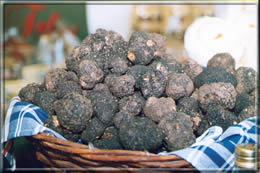
The black truffle (Tuber Melanosporum Vitt.) looks fairly smooth and round with polygonal warts. The black winter truffle has a trama that acquires a blackish shade of purple when fully ripe. The main characteristics to distinguish the different species are: the soil, the plants with which the truffle has a symbiotic relationship and the area or the countries in which the truffle grows. The black truffle is found in France (Perigord, Vaucluse) and in Norcia, Umbria. That is why the black truffle is known as The Norcia or Perigord black truffle. The flesh is clear, its perfume is intense, aromatic and fruity.
It grows in hilly and mountainous areas in symbiosis with hazel and oak. After the white truffle, it is considered the most valuable commercially and is a significant ingredient in international cuisine. Its collection period is from December to March.
Black Summer Truffle (Tuber Aestivum Vitt.)
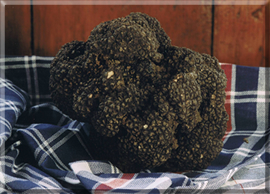
The black summer truffle sometimes reaches big dimensions and looks similar to the black winter truffle. The external surface has brown colored pyramidal warts. It has an aromatic smell, but once cut it is possible to distinguish it from the black winter truffle because the gleba does not become dark and instead acquires a dark yellow color.
It grows both in sandy and clavely soils. It is well appreciated and used for the production of sausages and sauces.
Bianchetto (Tuber Borchii Vitt.)
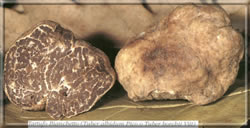
“Bianchetto truffle” also known as “Marzuolo truffle” (Tuber Borchii Vitt.) is abundant in Tuscany, Piedmont and Marche regions. Externally it can be confused with the Tuber Magnatum because at a first glance it shows the same characteristics: irregular, smooth and off-white color but the difference is that when it ripens, it becomes darker. Even the trama (also called the context or flesh) from fair become darker. The smell is the main characteristic that distinguishes it from the white truffle, because if it is soft and pleasant at the beginning, it becomes garlic-like and nauseating after some time. It grows in limestone soils, often in deciduous and coniferous trees. The collection period is from January to March.
Black winter Truffle (Tuber Brumale Vitt.)
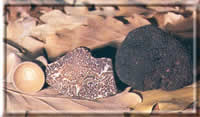
Black Winter Truffle or Brumale (Tuber Brumale Vitt.) is often confused with the black truffle because they share the same habitat and the same type of plant symbionts. It is brownish black with a slightly warty surface. Inside, the flesh darkens highlighting the white veins. It smells like nutmeg and grows in the winter under deciduous plants in temperate climates. Commercially its value is halved compared to the prized black.
Bibliography and images
- Tutto tartufo, Centro Nazionale Studii Tartufo
- Truffle_(fungi) (2009, November 20). In Wikipedia, the free encyclopedia. Retrieved November 20, 2009, from http://en.wikipedia.org/wiki/Truffle_%28fungi%29
- Where are the images of the website from?


